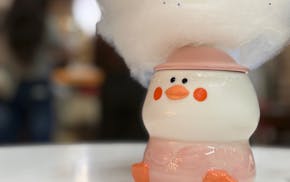Baby birds open their eyes for the first time in a wide variety of situations. For very young kingfishers, their first sight will be the dirt walls of a streamside burrow. Young eagles gaze out at the sticks that form their nest's walls, high in a tree. And very young barn swallows blink at the world from a mud-ball nest plastered beneath a bridge or culvert.
Summer is the most important season for birds, as adults raise the next generation. This is the reason they undergo the rigors of migration, in order to provide the best possible conditions for their broods. They need the open spaces and the lush larder found at northern latitudes for their nestlings.
Cups rule
The most frequent type of nest and nest placement in the avian world is the one we're most familiar with, a cup nest hidden in a leafy tangle in tree or shrub. One of our favorite back-yard birds, the cardinal, is a cup-nest builder whose final product sits nearly invisibly deep inside dense shrubbery or vines. The female cardinal does most of the work, first crushing twigs in her strong beak, then bending them into nest shape around her body. The nest isn't attached to twigs but instead is wedged into a tight space, and then the mother-to-be lines the cup with soft strips of bark, grasses and leaves.
One of the most sophisticated nests is crafted by the female Baltimore oriole, which spends days poking and pecking plant fibers into shape. This activity weaves and ties the fibers into complex knots that can withstand the continual buffeting that occurs at the tip of a branch, usually high in a cottonwood or maple.
Young birds might recall their natal nests, but don't see them being built, so the instructions must be hard-wired into their brains. Research shows that they get better at it as the years go on: For instance, they drop blades of grass less often in later years, so there is a learned element, as well.
Bug-proofing?
Some city bird nests contain cigarette butts woven into the walls. When people first learn of this fact, their reaction generally is to lament the effect humans are having on urban bird life. But it might not be a bad thing: Tobacco plants create the chemical nicotine to drive away beetles that might eat their leaves. Several butts in a nest may have a similar effect on parasites that might chew on nestlings, but what we don't know is the effect of this toxin on the young birds themselves.
Nesting season means an insect diet in the bird world. Even if they're seed-eaters the rest of the year, parent birds and their nestlings require a great deal of protein and energy in this demanding period, so nearly all birds become insectivores in spring and summer. (The only exceptions I can think of are goldfinches and house finches, which stick to a seed diet.) For tiny young birds, the perfect food is young caterpillars, which are small, soft, rich in protein — and abundant. Parents dash out of the nest and return time and again with beaks stuffed with insect life.
Climate effects
One of the concerns about climate change, as it relates to migratory birds, is that breeding birds and insects may no longer be synchronized. Long-distance migrants depart their wintering grounds on an ancient schedule tied to changes in day length. But insects hatch when conditions are favorable locally, and this may be occurring earlier each spring (this spring's anomaly aside). The vital insect "bloom," timed to temperature, may have occurred days or weeks earlier. Birds might arrive too late to find a good crop of small caterpillars to meet the needs of tiny, hungry nestlings. This could negatively affect bird populations, especially here in the North.
If you want to help birds during their most arduous season, keep the birdbath clean and feeders filled. Once young birds leave the nest, their parents will introduce them to food sources. If that includes your back-yard feeders, the birds might return, season after season.
St. Paul resident Val Cunningham, who volunteers with the St. Paul Audubon Society and writes about nature for local, regional and national newspapers and magazines, can be reached at valwrites@comcast.net.

The 5 best things our food writers ate this week

A Minnesota field guide to snow shovels: Which one's best?

Summer Camp Guide: Find your best ones here

Lowertown St. Paul losing another restaurant as Dark Horse announces closing
